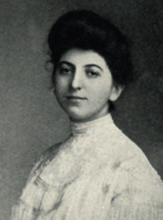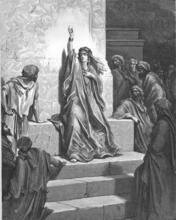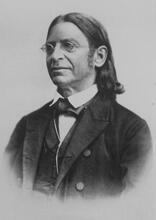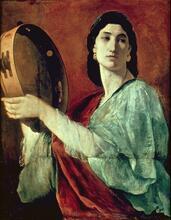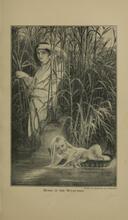Tanyaderas
Tanyaderas are Sephardic Jewish women who led song and dance for life celebrations, especially the many events that were part of a wedding. Typically, they used a frame drum to accompany their singing, and offered both ballads and lively songs in Ladino. Much of what we know of the Tanyaderas is based on ethnographic study from the nineteenth- and twentieth-century Sephardic communities and relatively recent historical records. Sephardic refers to Jewish communities of the Mediterranean descended from Jewish exile from Spain in 1492, though sometimes also refers to Jews of Spain. This article focuses primarily on the Tanyaderas from Balkan, Turkish, and Moroccan communities, but also looks at antecedents of these women leaders in biblical, historical, and visual records from medieval Spain.
Tanyadera is a Descendants of the Jews who lived in Spain and Portugal before the explusion of 1492; primarily Jews of N. Africa, Italy, the Middle East and the Balkans.Sephardic Jewish name for women who led song and dance for life celebrations, especially the many events that were part of a traditional wedding. Typically, Tanyaderas used a frame drum to accompany their singing and offered both ballads and lively songs in Ladino (Judeo-Spanish). According to Amnon Shiloh, the word Tanyadera refers to “drumming” (Shiloah 176), and he notes that the women had ritual expertise in conducting the procedures for these events that occurred primarily outside the synagogue.
Much of what we know of the Tanyaderas is based on ethnographic study from nineteenth- and twentieth-century Sephardic communities, and from relatively recent historical records. Although “Sephardic” generally refers to Mediterranean Jewish communities descended from Spain, it may refer to Jews who lived in Spain prior to expulsion in 1492 This article focuses primarily on the Tanyaderas from Balkan, Turkish, and Moroccan post-Expulsion communities but also looks at antecedents of these women leaders in biblical, historical, and visual records from medieval Spain.
Biblical Origins
Some evidence suggests that women were drum-dance and song leaders in Ancient Israel. Carol Meyers writes of ancient terra cotta figurines discovered in archeological digs in the Near East that appear to be women holding frame drums and instruments. By considering biblical texts about women’s performance traditions, she determined that these figurines depicted a professional women’s drum-dance-ensemble. Looking at biblical passages from Isaiah, Psalms, and historical books naming types of instruments and times of performance, Meyers states “it is clear from artistic depictions of musicians recovered in archaeological excavations in the Near East that women as well as men played all the instruments.” Furthermore, she found “a distinct musical tradition in which only women are the instrumentalists.” These traditions are portrayed in the biblical text as “women playing drums” that “are associated with dances (m’holot) and also with song.... Perhaps the best example is the so-called Song of Miriam” (Meyers 1993, 60-61). Miriam leading the congregation in dance at the shore of the Reed Sea in Exodus (Exodus 15:20-21) is the pre-eminent example, and also women greeting a victorious King Saul with singing and dancing (1 Samuel 18:6-7).
As Meyers indicates, the Hebrew word used for dance in most of these passages is “machol” suggesting a whirling or writhing dance. Like Meyers, Wilda Gaffney determined that these passages describes an activity that was important in Ancient Israel given Miriam is named a prophetess. Gaffney then links biblical women’s singing and dancing with prophecy (Gaffney 2008). The biblical book of Jeremiah also mentions that women playing timbrels will lead Israel in celebration upon return from exile (Jeremiah 31:4). In all, these biblical images suggest that women’s song and dance leadership was a respected tradition during the biblical period. Later texts and medieval images suggest that Jewish women’s song-dance leadership was normative in Mediterranean Jewish communities.
Medieval Haggadot
Medieval Spanish Passover Haggadot paintings might indicate the existence of a Tanyadera tradition in medieval Spain, with women gathering to celebrate religious events through dance and drumming. A reading of these pictures provides a surprising amount of evidence about community history and might allow a better understanding of the meaning of women’s dance and song leadership for festive celebration. Judith Brin Ingber, for example, noted the stance of the figures might indicate dances with hip motion.
Illuminated medieval Spanish Haggadot all include a page or section of images of women dancing. Depictions of Miriam and women celebrating at the shores of the Red Sea appear in the Golden Haggadah and the Sarejevo Haggadah, both from the fourteenth century. The thirteenth- or fourteenth-century Hispano-Moresque Haggadah and the fourteenth-century Sister Haggadah from Barcelona include paintings showing women dancing with women and a female drum-dance leader (Sautter 52-59). The images match what is known of Jewish women’s dance in medieval Spain and data regarding the drum-dance practice of Sephardic women in post-Expulsion Sephardic communities (see Metzger 146-147; Narkiss 45, 77-78; Ivanova 42-44, 54).
Although the culture and the activity of the Sephardic Tanyaderas were influenced by the surrounding non-Jewish community’s music and dance practices, their activities might provide clues to what is depicted in the Spanish Haggadot. In Sephardic communities such as those in Turkey, the Balkans, and Morocco, there were often groups “… of three women invited to sing and drum at all the ceremonies” who were trained “not only in the musical repertoire, but in all the customs.” Significantly, they were “ actually the ones who conduct[ed] the ceremonies and supervise[d] the details.... Tanyaderas led the ceremonies and sang, amusing the women and making them dance” (Shiloah 176). How the practices of the Sephardim are rooted in the practices of medieval Spain remains uncertain, but it is reasonable to assume that as part of the culture of the Islamic and Mediterranean worlds, Jewish women performed these dance rituals with a regional flavor, including strong hip movement in their dance.
Wedding Dances
Sephardic communities had many unique wedding customs. Tanyaderas usually led these events through their distinctive songs and dances, as they helped the community fulfill Jewish requirements for rejoicing at a Jewish wedding. Research on these practices offers details from nineteenth- and twentieth-century performances, with some understanding that they were a long-standing tradition. One important song event of the Sephardic women’s (Sephardiyot’s) wedding repertoire was for the evening of the bride’s visit to the ritual bath, the mikveh. One example is Y fuérme a baña (I went to the bath), which reflects a mix of local Jewish cultural and specific Jewish ritual. The lyrics are: I went to bathe/at the river’s bank/there I met, mother,/my handsome friend,/ he embraced me once,/ I embraced him five times./ Oh Lord our bride,/ beautiful body, what is the cream that you/use secretly? Is it white enamel/or gold dust?/ You will look so well/ in the eyes of your husband (Ben-Zaken). The words are fairly typical of the suggestive lyrics of many of the mikveh songs of the Tanyaderas.
Jewish law prescribes the bride’s visit to the mikveh, and it was clearly a special event for women in Sephardic communities. Songs and associated dance traditions also indicate that it was a time when Sephardiyot conveyed advice to the new bride. Referring to Sephardic scholar Esther Benbassa-Dudonney’s comments on the nature and meaning of this ritual in Turkey, Paloma Díaz-Maz remarks that while the event could be raucous, it was also meaningful. She notes that after the mikveh ceremony the women “ate baked goods and they drank raki (strong liquor) while singing and dancing in the bathhouse.” According to Díaz-Maz, this ceremony was of great importance; the event had purpose and meaning, rather than existing simply as a wild party for women (Díaz-Maz 1992, 30).
According to Esther Benbassa, a similar pattern of events occurred for Sephardiyot in the Balkan area. Her details on the post-mikveh music and dance event continue the story of the ritual. After dressing the bride or sometimes applying henna paste, the removal of all ritual objects, and the entrance and emergence from the ritual bath, the rite was completed with a women’s party. Dance at this ensuing party was often wild (Benbassa 36). While women in the Mediterranean world commonly have boisterous wedding dance parties, in a Jewish context, the transition from the mikveh to the party is particularly noteworthy. A controlled Jewish ritual turned into a rowdy women’s dance event.
In general, all aspects of the wedding experience included some forms of dance and ritual movement, with the ritual bath holding unique status as a women’s event specific to Judaism. The mikveh ceremony might then demonstrate how the Sephardiyot used dance as a means of expressing lived Torah, or action based on Jewish law. Other dance rituals in Sephardic wedding tradition involved a henna ceremony that occurred prior to the wedding, and the pantomimed dance and song Viva Ordueña (Hurray for Ordueña). This dance was usually performed after the wedding ceremony (Ben-Zaken; Weich-Shahak 1989, 77-78). There is limited evidence of the exact dances done in the past, but lyrics of the Tanyadera’s songs, along with local customs, might provide a general idea of movement employed and shed light on the circumstances surrounding the mikveh event, the possible purpose and meaning of the dance and movement among the Sephardiyot, and the role of the Tanyaderas.
Tanyaderas in Morocco also led singing and dancing at a henna party that involved painting the hands and feet of the bride-to-be with henna paste. Depending on the local community, prior to the actual wedding ceremony the bride’s trip to the mikveh either followed or preceded the henna party ceremony. In Tangiers the mikveh was held Monday night, before the henna party, and was called the baño de la novia (ritual bath of the bride) for the “married women (except for widows) of the bride’s family.” These women took the bride to the ritual bath, where “special honours [were] given to the groom’s mother and the bride’s own mother.” This included “undress[ing] the bride, with the help of the other women, before the bath,” and “dress[ing] her again afterward.” The henna ceremony occurred the following night. Called la noche de la novia (the night of the bride), it was “celebrated at the house of the bride’s family.” The bride’s hands were “painted with alhena” for the ceremony, and then, with “her eyes closed,” she was “led by her parents to the groom’s house.” A “hevrah,” consisting of “a choir,” accompanied her, “adding to the festivity of the occasion.” (Weich-Shahak 1989, 11-12).
Current practices of Sephardic women are conditioned by time, place, and cultural adaptation. Rabbi Lynn Gottlieb, for example reports that an event she attended in modern Israel included the use of drumming, “belly dance,” and lively singing (Gottlieb, 116-117; 130). Women of Sephardic descent report still practicing the henna ceremony and then holding a dance party, though reports seldom mention an official “Tanyadera leader.” These accounts seem to reflect both change and continuation of traditional activities (Sered 128).
In contemporary times, the role of the Tanyadera may be reduced, but Tanyaderas were ritual experts for life-cycle celebrations in Jewish communities. Their significance is noteworthy. Music and dance played a significant role in Jewish Mediterranean cultures, and women’s leadership outside of the synagogue held great importance for the Sephardim.
Benbassa-Dudonney, Esther. “El Kazamyento de los djuduos-espanyoles en Turkiya a la findel dizimueven siglo” in Actas de las Jornadas de Estudios Sefardies de 1981, Antonia Viudas Camarasa, ed. Caceres: Unversidad de Extremadura, 1981.
Ben-Zaken, Eti, translator. The Bride Unfastens her Braids. The Groom Faints: Ladino Love Songs, Berkeley, CA: Bay Records, 1999.
Cohen, Judith R. “The Music of the Songs: Musical Transcriptions and Commentary of the Songs Discussed by Oro Anahory-Librowicz in ‘Expressive Modes in the Judeo-Spanish Wedding song’ in New Horizons in Sephardic Studies, ed. Yedida K Stillman and George K. Zucker. Albany: State University of New York Press, 1993.
Cohen, Judith R. “Ya salio de le mar” - Judeo-Spanish Wedding Songs. In Women and Music in Cross-Cultural Perspective, ed. E. Koskoff. New York: Greenwood Press.
Diaz-Mas, Paloma. Sephardim: The Jews From Spain, translated by George K Zucker. Chicago and London: University of Chicago Press, 1992.
Dancing into Marriage: Collected Papers on Jewish Wedding Dances. Minneapolis: The Jewish Community Center of Greater Minneapolis, 1982. [Published in Dance Research Journal (Fall 1985-Spring 1986).]
Gafney, Wilda C. Daughters of Miriam: Women Prophets of Ancient Israel. Philadelphia: Fortress Press, 2008.
Gottlieb, Lynn. She Who Dwells Within: A Feminist Vision of a Renewed Judaism. New York: Harper Collins, 1995.
Ingber, Judith, ed. Seeing Israeli and Jewish Dance. Detroit: Wayne State University Press, 2011.
Ivanova, Anna. The Dance in Spain. New York: Praeger Publishers, 1970.
Larrea Palacin, A. Canciones rituales hispano-judias. Madrid: CSIC, 1971.
Metzger, Thérèse, and Mendel Metzger. Jewish Life in the Middle Ages: Illuminated Hebrew Manuscripts of the Thirteenth to the Sixteenth Centuries. New York: Alpine Fine Arts Collection, 1982.
Meyers, Carol. “Of Drums and Damsels: Women’s Performance in Ancient Israel.” Biblical Archaeologist 54 (1991): 16–27.
___________. “The Drum-Dance-Song Ensemble: Women’s Performance Traditions in Biblical Israel.” In Rediscovering the Muses: Women’s Musical Traditions, ed. by Kimberley Marshall, 49-67. Boston: Northeastern University Press, 1993.
Narkiss, Bezalel. The Spanish and Portuguese Manuscripts. Vol. 1 of Hebrew Illuminated Manuscripts in the British Isles. Part 1: Text. Part 2: Plates. Jerusalem: Oxford University Press for the Israel Academy of Sciences and Humanities and the British Academy, 1982.
Sautter, Cia. The Miriam Tradition: Teaching Embodied Torah. Urbana, Chicago, and Springfield: University of Illinois Press, 2010.
Serred, Susan Starr. Women as Ritual Experts: The Religious Lives of Elderly Jewish Women in Jerusalem. Oxford: Oxford University Press, 1996.
Shiloah, Amnon. Jewish Musical Traditions. Detroit: Wayne State University Press, 1992.
Stillman, Yedida. “The Art of Women Singing in Morocco.” in African Jewry in the Nineteenth and Twentieth Centuries, ed. M. Avitbol. Jerusalem: Ben Zvi Institute, 1980 (English/Spanish/Hebrew).
Wecih-Shahak, Susana. Judeo-Spanish Moroccan Songs for the Life Cycle/Cantares Judeo Españoles de Marruecos para el cicle de la Vida. Jerusalem: The Jewish Music Research Centre, The Hebrew University of Jerusalem, 1989


